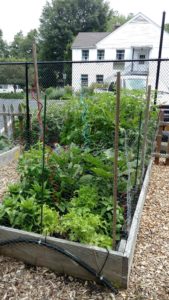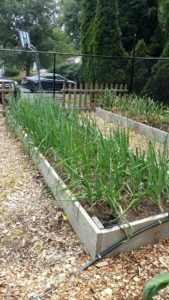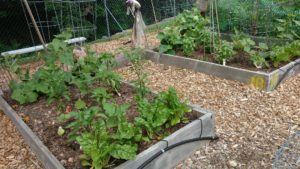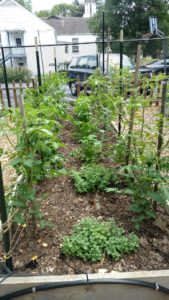I garden almost exclusively in raised beds and find that the pros significantly outweigh the cons. Let’s take a look below.

There are many pros and a few cons in choosing to garden with raise beds.
Pros –
You Pick the Soil – This is by far the biggest asset to raised bed gardening. I will get into this in more detail in an upcoming post, but being able to choose what I want my soil made from is a big plus. I prefer a soft soil that drains well.
Since I plant many root crops like onions, carrots, garlic and potatoes, having a soft texture to my soil, free of rock, is a must. I use a combination of organic material, like compost, leaf mold, sphagnum peat moss and coco cure to make up the bulk of the soil bed. I also add worm castings, a fine organic fertilizer and rock dust. Again, more on this in a future post.

Root crops like onions and garlic prefer a light, soft texture soil to allow them growing room.
Extend the Growing Season – Raised beds heat up faster allowing you to plant earlier in the Spring. Here in the Northeast winters seem to last forever, with freezing temps well into April.
Raised beds allow early planting of many garden favorites like cauliflower, broccoli, spinach and most lettuce varieties to just name a few. The earlier I can start eating out of my garden the better I feel.

Chard started in mid March is seen still thriving in late May.
Improve Drainage – Raised beds filled with the right soil combination will drain significantly better than your typical garden bed.
Proper drainage is important, especially in areas prone to rainy seasons and heavy downpours. The last thing you want is excessive moisture drowning out your plants roots. Good drainage is also important if you plant in pots.

Good drainage is important in pots as well as raised beds.
Eliminate Traffic in your Bed –Traffic, be it foot, animal or kids has an adverse effect on your garden bed by compacting the soil.
As mention earlier we’re looking to keep out soil soft and healthy to achieve proper aeration. Raised beds act a barrier against unwanted traffic and also keep you the gardener from compressing the soil with your feet.
Other benefits of raised beds include better weed control, less bending and stress on the body, as well as having your plants avoid contact with contaminates like lead and other harmful chemicals that may be present in your soil. Raised beds also make smart use of your space and just look nicer.
Cons –
The above pros may have you halfway out the door with your plans on starting a raised bed garden. Wait they are some things you need to consider before you make the leap to raised beds.

A drip irrigation system to your raised beds is useful when the season turns hot and dry.
Cost and Time – a big factor. I made most of my raised beds from recycled material found at construction sites and from discarded pallets. I spend little money but a great deal of time, and as dad always said, “Time is Money.”
If you plan to purchase raised beds (and I provide a few links below) realize they could be costly. Many of the beds available are really attractive and if you have the cash, go for it. If you decide to build them yourself, the best material is cedar wood which is not cheap but will last longer.
Maintenance – Raise beds are usually made from wood and over time will need to be replaced or repaired.
Additional and more importantly is that your soil will need to be amended each year and will cost you a few bucks each season. Also raised beds and a rototiller don’t get along to well, so the work of soil amending is a bit physical and more hands on.
Raised Beds Can Heat Up – Earlier I mentioned how raised beds retain heat and allow you to get a jump on the growing season. Well they don’t cool down any faster in the hot dry dog days of summer.
You can expect to water more often especially in drier regions. If you should be away from your beds for any length of time, be certain to make arrangements to have the beds watered daily. I installed a drip irrigation to my beds set on a timer, I highly recommend this.


Links to some cool raised beds:



















